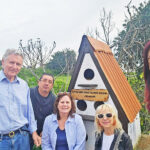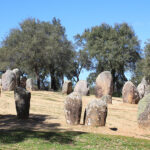Immigrants and Expats in Lagos from 1897 to 1972
Once again, the Livro de Registo de Bilhetes de Residência de Estrangeiros book, held by the Arquivo Municipal de Lagos, provides us with more intriguing life stories.
This month the foreign registry book leads to the investigation of an old occupation – the tanoaria. Translated in English as ‘cooperage,’ it is a forgotten art. Many years ago, the tanoaria made and repaired wooden casks, barrels, vats, buckets, troughs, oaks and other similar containers from timber staves that were usually heated or steamed. These containers were used not only to store or transport liquids, such as wine and other beverages, but also to keep goods like fish.
Although this profession no longer exists in Lagos the influence of the tanoeiros can still be seen in the naming of one of the crossroads in the old city: the Travessa dos Tanoeiros. Walking along the bustling 25 Abril Street, in the direction of this crossroad, we may find some traces of that period of history. Perhaps this will allow us to travel back through time and discover a glimpse of the tanoarias as they once existed. Although we won’t literally be able to time travel, we may feel nostalgic about those days from the past.


The tanoaria industry was given the status of third-class (in line with the legislation at the beginning of the 20th century), due to the inconveniences it caused (noise, smoke and the danger of fire). The name Travessa dos Tanoeiros has existed since at least 1924. We can affirm this using the city plan of Captain Raul Frederico Rato. This Is a very important document detailing the urban history of Lagos. The reading of this plan was possible due to the work of the architect Armando Amaro, who studied it for his thesis on Lagos’ canning industry.
Over the passage of time, many Lagos streets have changed their names but the Travessa dos Tanoeiros kept its original designation. To discover its true origins more research would be needed. Was the crossroad named because of the importance of the activity to the area? Was it named because of the number of workshops in existence? In which century was the crossroad named and what was its prior name?
The book Livro de Registo de Bilhetes de Residência de Estrangeiros tells us the names of the immigrants that had this occupation at the beginning of the 20th century. In 1916, when the book began its documentation of the occupations, four foreign “tanoeiros” were recorded.Two came from Austria: Venceslav Miroslav Sasso and Ivan Kandija. Two more were from Italy: Giuiseppe Mineo and Vito Anello.

Vito Anello, 30 years old, from Trapani, Italy, requested his first licence in 1906 for a period of one year. He was married, but he came alone. In 1916, Vito requested a new licence but this time with the inclusion of his wife, Rosa Galia Anello, 35 years old, “doméstica” (housekeeper), and also for his sons and daughters, Elisabeta Anello, three years old, born in Trapani, Italy; Vincenzo Anello, three-years-old, and Gaspare Anello, one-year-old, both born in Lagos and Brigida Anello, one-month-old, also born in Lagos! There are records for the family Anello until 1918 (the duration of the titles was for six months with the date, 9 March, 1918). The book does not include information for the years 1920 to 1923 so we do not know if the family stayed in Lagos for a longer period. We do know that no further information about the Anello family was included in the book from 1924 onwards.
Another tanoeiro, Giuiseppe Mineo, 26 years old, single, also from Trapani, Italy, requested a licence in 1916 for six months. This is the only record we have of him.
Venceslav Sasso requested a licence in 1905. From the records we can gather that he stayed for a good period of time. In 1905 the book did not provide information regarding occupation, status and other data that would become available a few years later. In 1906, the book provides more status information when we are able to see that Venceslav Sasso was married and came from Austria.

In 1916, the book started to provide information about the immigrant’s occupations. From this time, we can gather that Sasso had the occupation of tanoeiro. In 1918, his Portuguese wife was also recorded in this book: Luiza da Encarnação Bandeira Sasso, 34 years old, “doméstica” (housekeeper) from Lagos. Their daughters and sons are also listed: Emilia Venceslau Sasso, 13 years old; Constantina Rosa, four years old (without the Sasso surname); José Venceslau Sasso, 12 years old; Mario Nicolau Sasso, 10 years old; Demosthenes João Sasso, 8 years old and Domingos Anjos Sasso, 2 years old, all born in Lagos. Luiza da Encarnação Bandeira Sasso, born in Lagos, daughter of José Maria Bandeira and Rosa d’Assumpção Bandeira, adopted the nationality of her husband (this information appears in the record in 1927).
Ivan Kandija is another tanoeiro, aged 37, married, from Austria. He requested his first licence in 1916 for six months. He continued to apply for licences until the year 1919, after which no further records are available.
In 1918, we noticed a record of Franc Melic, from Austria, with the occupation of tanoeiro, he was 33 years old and married. In 1919, he was recorded as Francisco Milich, which looks like a Portuguese version of his name. In 1919, there is also a record for his wife, Gjurk Milich, but no other information is given about her . These are the only years in which we have records for Franc Melic.
We were fortunate to have access to a wonderful image of a group of tanoeiros in Lagos taken at the beginning of the 20th century. This image was provided by Fototeca Municipal. Francisco Castelo told us that the image was donated to the Fototeca by José Paula Borba and that this showed a building that formerly existed on Rua Infante de Sagres. With the help of Vito Anello’s granddaughter, Francisco Castelo, he was able to identify Vito Anello in this image (the second man from the left).
This is a powerful image that provides interesting historic details. In the picture, we see a number of people, adults and children (one of the children at the front of the image holds a piece of wood in his hand and another is with one leg inside a barrel in a playful mood). There are hammers and other tools together with materials and metal strips on the floor. The adults and children are posing for the photo in a way that recreates their tasks and the items on display would be those used for the task of cooperage. Given the light and arrangement, we would suspect that the photo was taken outside. This photo speaks of the lives of the people included in the picture and seems to say “this is what we do.”
There are many more life stories yet to be discovered through the Livro de registo de bilhetes de residência de estrangeiro. These foreign lives and their fascinating histories deserve to be known.
Part 5 – to continue
Marta Nogueira – Arquivo Municipal de Lagos – Câmara Municipal de Lagos
References:
Arquivo Municipal de Lagos (AMLGS) – Fundo da Administração do Concelho – Livro de registo de bilhetes de residência de estrangeiros (AMLGS – E122/P6/301/1).
Arquivo Municipal de Lagos (AMLGS) – Legislation – Diário do Governo. I Série, 2 setembro 1922. Decreto 8364. p. 932-946. Also available online in the website of Imprensa Nacional-Casa da Moeda
AMARO, Armando – Pormenor of the Plan of 1924 based on the urban survey of Raul Frederico Rato (2020)
FIGUEIREDO, Cândido de – Novo Dicionário da Língua Portuguesa, 3.ª edição, vol. 1 (A-I). Imprensa Portugal-Brasil: Lisboa, 1922.
Arquivo Municipal de Lagos (AMLGS) – Livro de registo de bilhetes de residência de estrangeiros (AMLGS – E122/P6/301/1)
About secular professions in Portugal check the Portuguese research project MedCrafts: crafts regulation in Portugal in the Late Middle Ages (14th-15th centuries) – medcrafts2021.wixsite.com/medcrafts
In the Portimão Museum there are some photos that illustrate it: “Barricas de salmoura de biqueirão “ from the fish-canning factory of Ferragudo from Júdice Fialho, 1985 – 9×13 cm – Autor José Gameiro (MP-D2-3C-D). The “barrica“ was a small barrel to keep groceries “(…) pequena vasilha, em forma de pipa, para objetos de mercearia ou drogaria”. Novo Dicionário da Língua Portuguesa, 3.ª edição, vol. 1 (A-I), Cândido de Figueiredo, Imprensa Portugal-Brasil, Lisboa, 1922. p. 254. About the canning industry in Lagos, check the research of the Architect Armando Amaro and the project Conservas de Portugal, Museu digital da industria conserveira – https://conservasdeportugal.com
Diário do Govêrno n.º 181/1922, Série I de 1922-09-02, Decreto 8364 – Aprova os regulamentos da higiene, salubridade e segurança nos estabelecimentos industriais, e das indústrias insalubres, incómodas, perigosas ou tóxicas. (Industrias ou depósitos:) “Tanoaria (oficina de) nas cidades e vilas, empregando mais que 10 operários” – (classe:) 3.ª (Inconvenientes:) Barulho, fumo e perigo de incêndio. p. 945.
The original plan is in the Documentation Centre of the Lagos Museum. The thesis of architect Armando Amaro is available at https://dspace.uevora.pt/rdpc/handle/10174/28687
About the urban evolution of Lagos check the work of the researcher Daniela Pereira – A evolução urbanística de Lagos (Séculos XV-XVIII), 1ª ed. – Faro : Direção Regional de Cultura do Algarve, 2017
AMLGS – E122/P6/301/1, p.6













